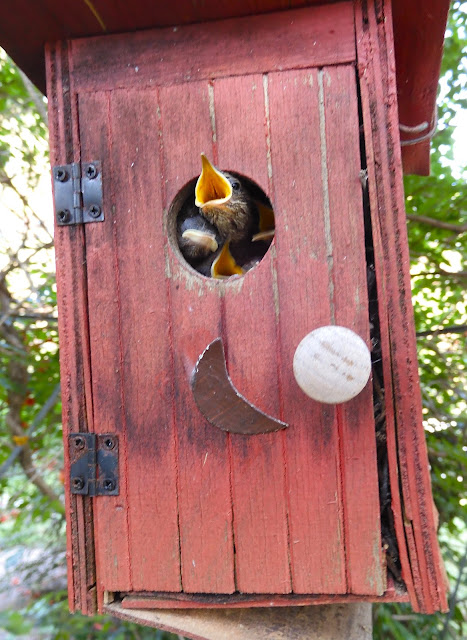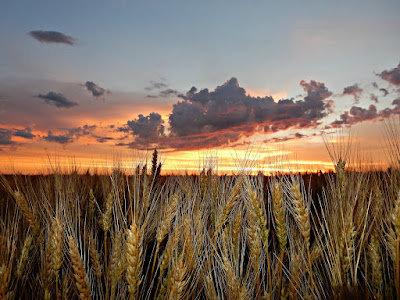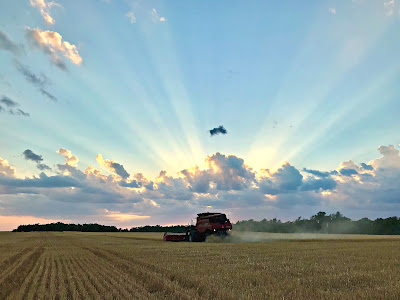 |
| Photo note: This and all the other photos in this post - with the labeled exception - are from the Kim's County Line archive. |
|
It may seem an archaic custom in 2024. But, back when I was a teenager in the 1970s, girls often received "hope chests" as gifts. Historically, it was a place to store linens and other household goods and the cedar-lined box kept away moths and pests. I believe I got my hope chest when I graduated from high school. It still sits in our bedroom and has my kids' outfits they wore when they came home from the hospital, among other "treasures."
But it was a "hope chest" of another kind that continues to impact
Kansas today. This chest delivered Turkey Red Wheat seed
thousands of miles from the Ukraine to the United States, where
Mennonites looking for religious freedom hoped to make a new life. And
they did just that, planting the wheat kernels that helped transform Kansas'
wheat industry.
 |
Seed chest exhibited at the Mennonite Heritage and Agricultural Museum, Goessel, KS. Photo from History.com
|
Bernhard Warkentin, the
son of a Mennonite miller who is credited with setting up Ukraine’s
prosperous wheat industry, came to the United States in 1871 to scout
possible sites to do the same in America. Along with several of his fellow Mennonites, he traveled
for two years by both horse and train covering a distance of over
10,000 miles in places like Canada, the Dakotas and Minnesota, looking
for the ideal terrain.
In Kansas, he found what he was looking for: “The climate
here is similar to that of the steppes in Ukraine,” says Fern Bartel,
director of the Mennonite Heritage and Agricultural Museum in Goessel,
Kansas. “Long winters.
Dry in the summer, rainy in the fall and spring.”
From History Channel's "The Tools that Built a Nation"
In 1874, Warkentin settled in Halstead, Kansas, building a grist mill on the banks of the Little
Arkansas River and encouraging other Mennonites to join him. Some 12,000 Mennonites moved to Kansas, mainly as a result of Warkentin's efforts. Many of them became wheat farmers.
Wheat Harvest 2024 got under way in our area on Saturday, before being curtailed by a nice 1.70 inches of rain Saturday night into Sunday morning. (The rain was too late to help this year's wheat, but it certainly helped the spring-planted corn and soybean crops, alfalfa, pasture lands and farm ponds. Nobody around here was complaining about the delay to wheat harvest.)
Maybe the start and stop story of harvest is not so different from that of those immigrating farmers years ago. Certainly, the ultimate goal has not changed - using the land to produce food and fiber for the world while also providing for our own families.
During Wheat Harvest 2024, we celebrate 150 years of Turkey Red Winter Wheat in Kansas.
Before
the Mennonites came to the region, many farmers who'd moved from the
eastern regions of the U.S. were planting spring wheat, which was more
acclimated for the Eastern seaboard. However,
Kansas’s summers are
hot, dry and windy, not ideal for wheat seedlings to thrive and
produce a crop. On top of that, grasshopper swarms in the summer would
completely devour what wheat did manage to survive.But the influx of Turkey Red - a hardy winter wheat - was more suited to Kansas' climate.

The
Mennonite farmers arrived less than 10 years after the 34th State of
the Union adopted the Homestead Act of 1862. It gave citizens or future
citizens up to 160 acres of land
if they lived on and improved it for five years. Many of those new
immigrants from Ukraine took advantage of the Homestead Act to establish
their own farms in Central Kansas. The first field
of Turkey Red wheat was planted in Marion County in 1873 and harvested
in the summer of 1874. The Mennonite farmers also brought new ideas to
the region, Kansas Wheat reports.
They also brought game-changing farming practices like leaving fields
fallow in between planting cycles, applying fertilizer to fields and
using large threshing stones to separate the wheat kernels from the
stalks that enveloped them. Turkey Red was revolutionary, but it
took time for the milling industry to adjust from milling soft wheat
with lower protein and weaker gluten (think soft cookies) to the new
hard red winter wheat, which had higher protein and stronger gluten
(think of a loaf of bread that holds its shape). Just as the farmers
discovered the hardiness of Turkey Red and the millers unlocked its
better quality, the variety quickly spread and took over Kansas
agriculture.
From a story from Kansas Wheat by Julia Debes, June 2024
At the same time, railroad
lines expanded, communities were settled and giant elevators to store grain were
built.Turkey Red Wheat was one of the more popular varieties of wheat in Kansas until the 1940s, when higher–yield crops overtook it. But even today's varieties can trace their
pedigrees back to foundations in Turkey Red hard winter wheat or other
Crimean varieties. Kansas wheat accounts for nearly 20 percent of all wheat grown in the United States today.
[Turkey Red] genetic material is still the foundation of our varieties
today. We’ve shortened them, we’ve given them stronger
straw, we’ve improved drought tolerance and we’ve hopefully improved
quality. But that’s really still the scaffolding on which everything is
built.
Allan Fritz, Kansas State University
wheat breeder
Quote taken from a feature story by Jennifer Latzke in Kansas Farmer
Even today, visitors to the USDA Agricultural Research Service
Southern Regional Performance Nursery in Lincoln, Neb., will see a check
plot of Kharkov, a landrace similar to Turkey Red that is meant to show
how the current wheat varieties stack up to the historic record. The world has come a long way from a
13-bushel per acre average in 1919 to the record 57-bushel average set
in 2016 (also from the Kansas Farmer article)
Maybe the old farmers in the region looked at skepticism at those new farmers who brought different seeds and a different planting time table to the Kansas plains. However, Turkey Red winter wheat - and, ultimately, its descendants - were here to stay.
Just
like the farmers of today, those long-ago farmers who'd carried those
"hope chests" of seeds across the ocean didn't know what the planted
seeds would yield until harvest time. Today, researchers continue to
work on genetics that will improve yield and combat disease and
drought. Manhattan, Kansas, is home to the Wheat Innovation Center at Kansas State University. K-State
has a long history of sharing wheat germplasm with growers and farmers
around the world, Fritz says, even back to Ukraine, where Turkey Red
first originated.
“There
will only ever be one Turkey Red. That was really the foundation that
we kind of built this whole industry and this whole region’s wheat
production around."
Alan Fritz (quote from Kansas Farmer article)
 |
| Harvest 2021 |
Bernard
Warkentin likely never dreamed that the seeds he and his Mennonite
brethren were bringing to Kansas could one day lead to the state growing
244.2 million bushels of wheat in 2022, or 18 to 20 percent of the wheat crop
of the United States. He may not have imagined that wheat production in
the state would account for $4.3 billion of its economy and 15,245
jobs. Or that in 2023, half of every load of wheat that arrives at the
local elevator would be destined for foreign buyers.
But, I'm sure glad he included Turkey Red wheat in his own "hope chest" as he left all he knew behind for a new adventure in a new land.
***
For more information: The Goessel Museum is celebrating
the 150th anniversary of Turkey Red wheat . Be sure to visit goesselmuseum.com,
or stop by at 200 N. Poplar St., Goessel. Among the many exhibits
you’ll see is the Wheat Straw Liberty Bell, a giant woven wheat art
piece commissioned by the Smithsonian for display for the nation’s
bicentennial in 1976.
And,
to learn more about Turkey Red wheat’s influence in Kansas agriculture,
listen to Kansas Wheat’s “Wheat’s on Your Mind: Thresher Nation”
podcast episode, Wheat's on Your Mind, with Aaron Harries of Kansas Wheat and Glenn Ediger, author of “Leave No Threshing Stone Unturned,” a book about the Mennonites and Turkey Red wheat.















.jpg)














